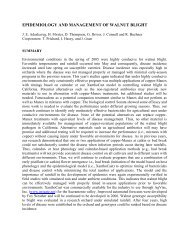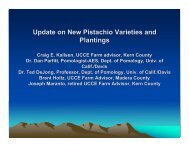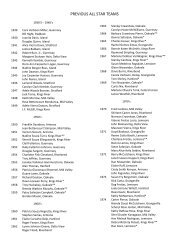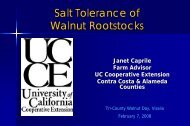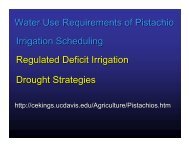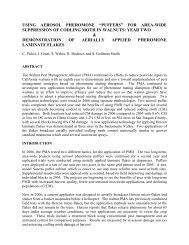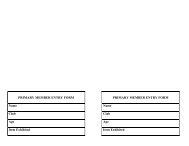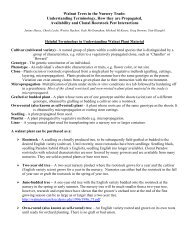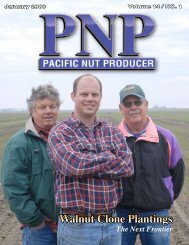nematode management in walnut orchards - Walnut Research Reports
nematode management in walnut orchards - Walnut Research Reports
nematode management in walnut orchards - Walnut Research Reports
You also want an ePaper? Increase the reach of your titles
YUMPU automatically turns print PDFs into web optimized ePapers that Google loves.
Nematodes washed from the sieve are then mixed with a sugar solution <strong>in</strong> a plastic tube and<br />
centrifuged. Dur<strong>in</strong>g this process, <strong>nematode</strong>s float <strong>in</strong> the sugar solution while any rema<strong>in</strong><strong>in</strong>g soil<br />
particles are pulled to the bottom by the centrifugation. Nozzles at the top of a mist chamber<br />
periodically spray heated water on roots held <strong>in</strong> a mesh basket nested on top of a funnel. The<br />
stem of the funnel resides <strong>in</strong> a test-tube. Nematodes emerge from the roots and are captured at<br />
the bottom of the test-tube while excess water flows over the top of the tube. For both<br />
techniques, extracted <strong>nematode</strong>s are then counted under a microscope.<br />
2. Evaluate performance of Quillaja 35% and DiTera <strong>in</strong> a Sutter County orchard.<br />
The study site is located <strong>in</strong> Sutter County <strong>in</strong> northern California on Holillipah loamy sand. Two<br />
rootstocks, micropropagated ‘Chandler’ on its own-roots and nursery grafted ‘Chandler’ on<br />
seedl<strong>in</strong>g Paradox rootstock were planted <strong>in</strong> 1991 <strong>in</strong> a randomized complete block design spaced<br />
at 25 ft x 25 ft. Trees are irrigated us<strong>in</strong>g microspr<strong>in</strong>klers.<br />
The nematicide trial has 10 <strong>in</strong>dividual tree replicates per treatment (5 Paradox and 5 own-rooted)<br />
for DiTera DF and Quillaja 35% <strong>in</strong> a randomized complete block design. In addition, a new<br />
formulation of DiTera is be<strong>in</strong>g evaluated on 2 Paradox and 5 own-rooted trees. Treatments were<br />
applied <strong>in</strong> 2003 (April 11 and October 24), 2004 (April 6 and September 29), 2005 (April 11 and<br />
October 13), and 2006 (May 10 and October 30) <strong>in</strong> a band cover<strong>in</strong>g half of the area, so that<br />
actual amounts applied per acre were 25 pounds of DiTera and 1.25 gallons of Quillaja.<br />
Treatments are <strong>in</strong>corporated with irrigation. The new formulation of DiTera was not applied to<br />
both rootstocks on all dates due to <strong>in</strong>sufficient product be<strong>in</strong>g available. Data for the new<br />
formulation has not been <strong>in</strong>cluded <strong>in</strong> the figures.<br />
Root and soil samples are taken prior to each treatment date us<strong>in</strong>g a 5 cm bucket auger to a depth<br />
of 60 cm midway between the dripl<strong>in</strong>e and tree trunk <strong>in</strong> the fall and spr<strong>in</strong>g of each year.<br />
Nematodes were extracted from a 400 cm 3 soil sub-sample with a modified semiautomatic<br />
elutriator and sucrose centrifugation technique (Byrd et al., 1976). Data were analyzed us<strong>in</strong>g<br />
analysis of variance followed by <strong>in</strong>dependent contrasts for mean separation or Fisher’s Protected<br />
Least Significant Difference Test.<br />
3. Evaluate performance of Quillaja 35%, DiTera, and Fulvic Acid <strong>in</strong> a San Joaqu<strong>in</strong> County<br />
orchard.<br />
In 2004, a trial was <strong>in</strong>itiated <strong>in</strong> a drip irrigated orchard <strong>in</strong> San Joaqu<strong>in</strong> County. It consists of<br />
DiTera, two rates of Quillaja (2.5 and 4 gpa), and Fulvic Acid treatments with four replicates per<br />
treatment. Treatments have been applied <strong>in</strong> the spr<strong>in</strong>g of 2004, 2005, and 2006. Treatments are<br />
applied through the drip irrigation system. Treatment effectiveness is be<strong>in</strong>g evaluated via soil<br />
and root sampl<strong>in</strong>g, and trunk circumference measurements. Data is be<strong>in</strong>g analyzed us<strong>in</strong>g<br />
analysis of variance followed by <strong>in</strong>dependent contrasts for mean separation.



